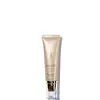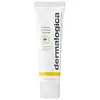What's inside
What's inside
 Key Ingredients
Key Ingredients

 Benefits
Benefits

 Concerns
Concerns

 Ingredients Side-by-side
Ingredients Side-by-side

Titanium Dioxide 3%
Cosmetic ColorantZinc Oxide 7%
Cosmetic Colorant1,2-Hexanediol
Skin ConditioningAllantoin
Skin ConditioningAlumina
AbrasiveBiotin
AntiseborrhoeicButylene Glycol
HumectantC12-15 Alkyl Benzoate
AntimicrobialCalendula Officinalis Flower Extract
MaskingCamellia Oleifera Leaf Extract
AstringentCaprylyl Glycol
EmollientCaprylyl Methicone
Skin ConditioningCetyl Alcohol
EmollientChamomilla Recutita Flower Extract
MaskingCitric Acid
BufferingCucumis Sativus Fruit Extract
EmollientCyclomethicone
EmollientCyclopentasiloxane
EmollientDimethicone
EmollientDisodium EDTA
Ethylhexyl Palmitate
EmollientEuterpe Oleracea Fruit Extract
Glycerin
HumectantGlyceryl Caprylate
EmollientGlyceryl Stearate
EmollientGlyceryl Undecylenate
EmollientHydrolyzed Yeast Protein
Skin ConditioningHydroxyethyl Acrylate/Sodium Acryloyldimethyl Taurate Copolymer
Emulsion StabilisingKaempferia Galanga Root Extract
Skin ConditioningLauryl PEG-9 Polydimethylsiloxyethyl Dimethicone
Skin ConditioningNiacinamide
SmoothingPanthenol
Skin ConditioningPEG-100 Stearate
Pentylene Glycol
Skin ConditioningPolyhydroxystearic Acid
EmulsifyingPolysorbate 60
EmulsifyingPropanediol
SolventPropylene Glycol
HumectantPyridoxine Hcl
Skin ConditioningSaccharomyces Cerevisiae Extract
Skin ConditioningSodium Citrate
BufferingSodium Hyaluronate
HumectantSodium PCA
HumectantThermus Thermophillus Ferment
Skin ConditioningTriethoxycaprylylsilane
Triethoxysilylethyl Polydimethylsiloxyethyl Hexyl Dimethicone
Skin ConditioningWater
Skin ConditioningXanthan Gum
EmulsifyingTitanium Dioxide 3%, Zinc Oxide 7%, 1,2-Hexanediol, Allantoin, Alumina, Biotin, Butylene Glycol, C12-15 Alkyl Benzoate, Calendula Officinalis Flower Extract, Camellia Oleifera Leaf Extract, Caprylyl Glycol, Caprylyl Methicone, Cetyl Alcohol, Chamomilla Recutita Flower Extract, Citric Acid, Cucumis Sativus Fruit Extract, Cyclomethicone, Cyclopentasiloxane, Dimethicone, Disodium EDTA, Ethylhexyl Palmitate, Euterpe Oleracea Fruit Extract, Glycerin, Glyceryl Caprylate, Glyceryl Stearate, Glyceryl Undecylenate, Hydrolyzed Yeast Protein, Hydroxyethyl Acrylate/Sodium Acryloyldimethyl Taurate Copolymer, Kaempferia Galanga Root Extract, Lauryl PEG-9 Polydimethylsiloxyethyl Dimethicone, Niacinamide, Panthenol, PEG-100 Stearate, Pentylene Glycol, Polyhydroxystearic Acid, Polysorbate 60, Propanediol, Propylene Glycol, Pyridoxine Hcl, Saccharomyces Cerevisiae Extract, Sodium Citrate, Sodium Hyaluronate, Sodium PCA, Thermus Thermophillus Ferment, Triethoxycaprylylsilane, Triethoxysilylethyl Polydimethylsiloxyethyl Hexyl Dimethicone, Water, Xanthan Gum
Water
Skin ConditioningZinc Oxide
Cosmetic ColorantCaprylic/Capric Triglyceride
MaskingC12-15 Alkyl Benzoate
AntimicrobialDimethicone
EmollientButyloctyl Salicylate
Skin ConditioningButylene Glycol
HumectantGlycerin
HumectantSilica
AbrasivePolyhydroxystearic Acid
EmulsifyingPEG-10 Dimethicone
Skin ConditioningArgania Spinosa Kernel Oil
EmollientCordyceps Sinensis Extract
AntioxidantTrametes Versicolor Extract
Sodium Hyaluronate
HumectantCamellia Sinensis Leaf Extract
AntimicrobialEucalyptus Globulus Leaf Oil
PerfumingLavandula Spica Flower Oil
MaskingTocopheryl Acetate
AntioxidantSodium Chloride
MaskingStearalkonium Hectorite
Gel FormingPentylene Glycol
Skin ConditioningLauryl PEG-9 Polydimethylsiloxyethyl Dimethicone
Skin ConditioningPropanediol
SolventDimethicone Crosspolymer
Emulsion StabilisingSodium Citrate
BufferingPropylene Carbonate
SolventXanthan Gum
EmulsifyingCaprylyl Glycol
EmollientBisabolol
MaskingLavandula Hybrida Oil
EmollientEthylhexylglycerin
Skin ConditioningSodium Hydroxide
BufferingPotassium Sorbate
PreservativeSodium Benzoate
MaskingLinalool
PerfumingLimonene
PerfumingWater, Zinc Oxide, Caprylic/Capric Triglyceride, C12-15 Alkyl Benzoate, Dimethicone, Butyloctyl Salicylate, Butylene Glycol, Glycerin, Silica, Polyhydroxystearic Acid, PEG-10 Dimethicone, Argania Spinosa Kernel Oil, Cordyceps Sinensis Extract, Trametes Versicolor Extract, Sodium Hyaluronate, Camellia Sinensis Leaf Extract, Eucalyptus Globulus Leaf Oil, Lavandula Spica Flower Oil, Tocopheryl Acetate, Sodium Chloride, Stearalkonium Hectorite, Pentylene Glycol, Lauryl PEG-9 Polydimethylsiloxyethyl Dimethicone, Propanediol, Dimethicone Crosspolymer, Sodium Citrate, Propylene Carbonate, Xanthan Gum, Caprylyl Glycol, Bisabolol, Lavandula Hybrida Oil, Ethylhexylglycerin, Sodium Hydroxide, Potassium Sorbate, Sodium Benzoate, Linalool, Limonene
 Reviews
Reviews

Ingredients Explained
These ingredients are found in both products.
Ingredients higher up in an ingredient list are typically present in a larger amount.
Butylene Glycol (or BG) is used within cosmetic products for a few different reasons:
Overall, Butylene Glycol is a safe and well-rounded ingredient that works well with other ingredients.
Though this ingredient works well with most skin types, some people with sensitive skin may experience a reaction such as allergic rashes, closed comedones, or itchiness.
Learn more about Butylene GlycolC12-15 Alkyl Benzoate is made up of Benzoic Acid and long chain alcohols. It has a low molecular weight.
C12-15 Alkyl Benzoate is an emollient and texture enhancer. Due to its solubility, it is often used in sunscreens to help evenly distribute active ingredients.
As an emollient, C12-15 Alkyl Benzoate helps soften and hydrate your skin. Emollients create a film on your skin that traps moisture within.
This ingredient has been reported to cause eye irritation.
Learn more about C12-15 Alkyl BenzoateCaprylyl Glycol is a humectant and emollient, meaning it attracts and preserves moisture.
It is a common ingredient in many products, especially those designed to hydrate skin. The primary benefits are retaining moisture, skin softening, and promoting a healthy skin barrier.
Though Caprylyl Glycol is an alcohol derived from fatty acids, it is not the kind that can dry out skin.
This ingredient is also used as a preservative to extend the life of products. It has slight antimicrobial properties.
Learn more about Caprylyl GlycolDimethicone is a type of synthetic silicone created from natural materials such as quartz.
What it does:
Dimethicone comes in different viscosities:
Depending on the viscosity, dimethicone has different properties.
Ingredients lists don't always show which type is used, so we recommend reaching out to the brand if you have questions about the viscosity.
This ingredient is unlikely to cause irritation because it does not get absorbed into skin. However, people with silicone allergies should be careful about using this ingredient.
Note: Dimethicone may contribute to pilling. This is because it is not oil or water soluble, so pilling may occur when layered with products. When mixed with heavy oils in a formula, the outcome is also quite greasy.
Learn more about DimethiconeGlycerin is already naturally found in your skin. It helps moisturize and protect your skin.
A study from 2016 found glycerin to be more effective as a humectant than AHAs and hyaluronic acid.
As a humectant, it helps the skin stay hydrated by pulling moisture to your skin. The low molecular weight of glycerin allows it to pull moisture into the deeper layers of your skin.
Hydrated skin improves your skin barrier; Your skin barrier helps protect against irritants and bacteria.
Glycerin has also been found to have antimicrobial and antiviral properties. Due to these properties, glycerin is often used in wound and burn treatments.
In cosmetics, glycerin is usually derived from plants such as soybean or palm. However, it can also be sourced from animals, such as tallow or animal fat.
This ingredient is organic, colorless, odorless, and non-toxic.
Glycerin is the name for this ingredient in American English. British English uses Glycerol/Glycerine.
Learn more about GlycerinLauryl PEG-9 Polydimethylsiloxyethyl Dimethicone is a type of silicone.
Pentylene glycol is typically used within a product to thicken it. It also adds a smooth, soft, and moisturizing feel to the product. It is naturally found in plants such as sugar beets.
The hydrophilic trait of Pentylene Glycol makes it a humectant. As a humectant, Pentylene Glycol helps draw moisture from the air to your skin. This can help keep your skin hydrated.
This property also makes Pentylene Glycol a great texture enhancer. It can also help thicken or stabilize a product.
Pentylene Glycol also acts as a mild preservative and helps to keep a product microbe-free.
Some people may experience mild eye and skin irritation from Pentylene Glycol. We always recommend speaking with a professional about using this ingredient in your routine.
Pentylene Glycol has a low molecular weight and is part of the 1,2-glycol family.
Learn more about Pentylene GlycolPolyhydroxystearic Acid is a soft wax made from castor oil.
It is is a texture thickener, emulsifier, and film-former. Emulsifiers prevent ingredients from separating, such as oils and waters.
Polyhydroxystearic Acid may not be fungal acne safe.
Learn more about Polyhydroxystearic AcidPropanediol is an all-star ingredient. It softens, hydrates, and smooths the skin.
It’s often used to:
Propanediol is not likely to cause sensitivity and considered safe to use. It is derived from corn or petroleum with a clear color and no scent.
Learn more about PropanediolSodium Citrate is the sodium salts of citric acid. In skincare, it is used to alter pH levels and acts as a preservative.
Its main functions are to maintain the pH of a product and neutralize metal ions.
The acidity of our skin is maintained by our glands and skin biome; normal pH level of skin is slightly acidic (~4.75-5.5).
Being slightly acidic allows our skin to create an "acid mantle". This acid mantle is a thin barrier that protects our skin from bacteria and contaminants.
Learn more about Sodium CitrateSodium Hyaluronate is hyaluronic acid's salt form. It is commonly derived from the sodium salt of hyaluronic acid.
Like hyaluronic acid, it is great at holding water and acts as a humectant. This makes it a great skin hydrating ingredient.
Sodium Hyaluronate is naturally occurring in our bodies and is mostly found in eye fluid and joints.
These are some other common types of Hyaluronic Acid:
Learn more about Sodium HyaluronateWater. It's the most common cosmetic ingredient of all. You'll usually see it at the top of ingredient lists, meaning that it makes up the largest part of the product.
So why is it so popular? Water most often acts as a solvent - this means that it helps dissolve other ingredients into the formulation.
You'll also recognize water as that liquid we all need to stay alive. If you see this, drink a glass of water. Stay hydrated!
Learn more about WaterXanthan gum is used as a stabilizer and thickener within cosmetic products. It helps give products a sticky, thick feeling - preventing them from being too runny.
On the technical side of things, xanthan gum is a polysaccharide - a combination consisting of multiple sugar molecules bonded together.
Xanthan gum is a pretty common and great ingredient. It is a natural, non-toxic, non-irritating ingredient that is also commonly used in food products.
Learn more about Xanthan GumZinc Oxide is a mineral broad-spectrum UV filter; it is the broadest UVA and UVB reflector approved by the FDA. It also has skin protectant and skin soothing properties.
Zinc oxide is one of the most effective broad-spectrum UV filters. It protects against UVB, UVAII, and UVAI. In comparison to its counterpart titanium dioxide, zinc oxide provides uniform and extended UVA protection.
Another great benefit? This ingredient is highly photostable so it won't degrade easily under sunlight.
A common myth is that mineral UV filters are widely believed to primarily reflect UV light.
However, modern research shows titanium dioxide absorbs UV radiation like chemical filters (~95% absorption & 5% reflection).
Zinc oxide has great skin soothing properties so you'll likely find this in sunscreens formulated for sensitive skin or babies/children. It is unlikely to cause "eye sting" like other sunscreen ingredients.
Regulatory agencies consider zinc oxide to be non-toxic and safe. It has also been shown to not penetrate the skin.
Unfortunately, this ingredient does leave a visible white cast. This is why mineral sunscreens are often less cosmetically elegant than chemical or hybrid ones.
In cosmetics, zinc oxide can be found in both non-nano and nano-sized forms. The nano version is used to reduce white cast and improve the texture of sunscreen formulas.
There are ongoing concerns surrounding nano-zinc oxide's impact on marine ecosystems and whether it can be absorbed into skin.
Regarding marine ecosystems and coral reefs, there is no conclusive evidence that any form of zinc oxide (or any other sunscreen ingredients) will cause harm. The science is still developing but many consumers are keeping a close eye on this issue.
Please note, many destinations have reef-safety sunscreen rules. For instance, the U.S. Virgin Islands advises all visitors to use non-nano mineral sunscreens.
There has also been some stir about whether micronized or nano zinc oxide has potential photoxicity and absorption through the skin/lungs.
An in-vitro (done in a test tube or petri dish) study demonstrated micronized zinc oxide to have potential phototoxicity. There's no need to fret; the EU Commission's Scientific Committee on Consumer Safety has stated, "The relevance of these findings needs to be clarified by appropriate investigations in vivo." Or in other words, further studies done on living organisms are needed to prove this.
Current research shows zinc oxide nanoparticles do not penetrate intact or sunburned skin. They either remain on the surface or in the outermost layer of dead skin (stratum corneum).
Zinc oxide is one of only two classified mineral UV filters with titanium dioxide being the other one.
Fun fact: Zinc has been used throughout history as an ingredient in paint and medicine. An Indian text from 500BC is believed to list zinc oxide as a salve for open wound. The Ancient Greek physician Dioscorides has also mentioned the use of zinc as an ointment in 1AD.
Learn more about Zinc Oxide